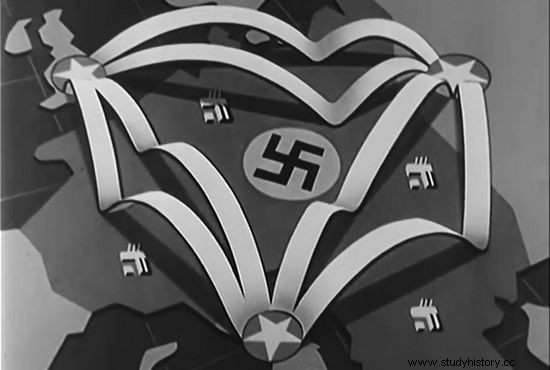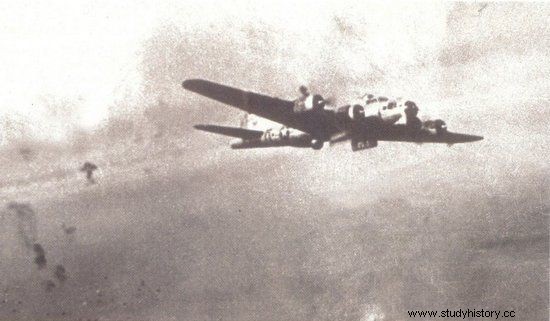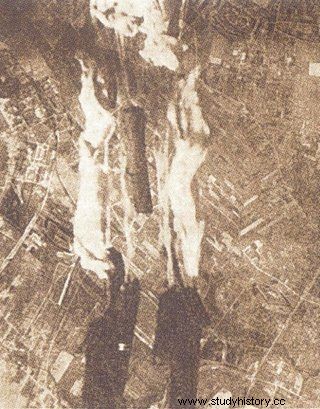It was September 18, 1944. Around At 2 p.m., the sky above the capital city was filled with the roar of hundreds of powerful aircraft engines. The great expedition of American bombers was coming. Its task was to drop weapons and supplies for the insurgents. The first, and unfortunately the only, operation of this type undertaken by the American air force failed to save the Poles.
The government in exile in Washington sought support for the Warsaw Uprising by air practically from the moment it broke out. As early as on August 6, 1944, Ambassador Jan Ciechanowski, acting on the orders of President Władysław Raczkiewicz, asked the Americans for such assistance. This met with a positive response from the US government and the US Air Force headquarters in Europe began to create operational plans.
It was assumed that the next operations, codenamed "Frantic", would be successfully delivered. These were shuttle flights. During them, American bombers, in a strong cover of fighters, taking off from bases in England or Italy, attacked targets in Germany or its allied states.

Jan Ciechanowski's efforts to obtain air support for the Uprising found fertile ground in Washington.
Then they landed at airfields assigned to them by the Soviets in Ukraine. After replenishing fuel and ammunition, they returned to their home base, again performing various types of combat tasks. By August 6, 1944, a total of five such operations were carried out.
Stalin says "nie"
During the prepared mission "Frantic 6", the Americans suggested to the Russians that they would bomb the Luftwaffe airfields indicated by them in the Warsaw area, and then drop weapons and supplies containers for the insurgents.
Stalin then vehemently protested and, despite the intervention of President Roosevelt himself, refused to accept American planes at his airports. The Soviet commander announced that the resumption of air expeditions would take place only under the condition that the Americans did not try to support the insurgents.
The scuffle continued for another month and Operation Frantic 6 did not take effect until September 11, when American bombers set off from British airports and attacked really meaningless targets in eastern Germany.
… and then changes his mind
Unexpectedly, on September 12, Stalin changes his mind and allows American bombers to land at Soviet airfields. It was by no means an act of mercy on the part of the Soviet dictator. The chief apparently calculated that the Uprising would collapse soon anyway, and even the American aid would not change this fact.

A still from the American propaganda film commissioned by the War Department entitled Operation Titanic. You can see here the flight paths of American planes taking off from bases in Great Britain and Italy and then landing at Soviet airports during Operation Frantic.
Meanwhile, the uprising was slowly dying down. At the beginning of September, the Germans finally captured the Old Town, and Sadyba fell. Śródmieście was attacked from several sides, with strong support from aviation and artillery. The insurgents lacked weapons, ammunition, food and medicines.
Under these conditions, on September 9, envoys of General Bor-Komorowski made contact with General Günther Rohr, one of the German commanders, regarding the capitulation talks.
At that time, however, a signal came from London about Stalin's consent to help the Uprising and the ensuing great Allied air expedition. Artillery noises could also be heard from the Praga side of the Vistula, which could suggest that the Red Army is actually going to the rescue of Warsaw. Therefore, on September 11, the negotiations were stopped.
Allied support for a tormented city
The American expedition, codenamed "Frantic 7", was to start on September 14. Unfortunately, the terrible weather conditions caused the planes to be grounded at bases in England.
On September 15, 110 B-17 "Flying Fortresses", protected by 150 P-51 "Mustang" fighters, were taken to a flight over Poland. However, the North Sea was again extremely bad weather and the expedition returned to England.
Another attempt was made on Monday, September 18, 1944. This time everything went well. At 5.55 am, 110 B-17s from 95, 100 and 390 Bomber Group took off for the flight over Warsaw. On the way, due to technical defects, three "Flying Fortresses" returned to their bases.

During the operation "Frantic", the protection of the "Flying Fortresses" was provided by the P-51 "Mustang" fighters. September 18, 1944 was no different. The photo shows "Flying Fortress" and two "Mustangs".
The American expedition flew over the North Sea and then, flying along the Baltic coast, crossed the shore near Koszalin. There, too, an escort of 64 "Mustang" fighters from the 355 Fighter Group was to join the B-17.
Meanwhile, the formation of "Mustangs" near Szczecin got into a little trouble, when the fighters fell under the targeted fire of the German anti-aircraft artillery. Several machines were damaged and one of the pilots was injured. The fighters joined the bombers only near Toruń.
This article has more than one page. Please select another one below to continue reading.Attention! You are not on the first page of the article. If you want to read from the beginning click here.
It was high time for this, because less than half an hour later the expedition was attacked from the forehead by German Messerschmitt Bf 109 fighters from 51 Jagdgeschwader. The clash took place near Nasielsk, about 40 km from Warsaw. The Americans shot down four German fighters, losing two pilots.
The USAAF suffers losses on its way to Warsaw

In the vicinity of the village of Wrona, the "Mustang" piloted by Lieutenant Robert Peters accidentally flew into a series of another P-51, firing at the same time into a Bf 109. The wounded American pilot managed to emergency plant a heavily damaged machine, but died a moment later.
Almost at the same time in Kątne, during a low-altitude chase after the escaping Messerschmitt, he hit a tree and exploded a "Mustang" piloted by Lieutenant Joseph Vigne. The pilot died on the spot.
Despite counteracting the Mustangs, a few Bf 109s broke through to the vicinity of the protected bombers. One of the B-17s of the 390 Bomber Group was successfully fired upon by German fighter ace Lieutenant Günther Josten. The pilot, Lieutenant Francis Akins, was killed by a missile from a Messerschmitt 20mm cannon.
The co-pilot failed to control the machine and the "Flying Fortress" crashed near Dziekanów Leśny. Out of the crew of ten, only three pilots jumped on parachutes. One of them, a Pole by origin, a deck gunner, Sergeant Walter Shimsock (Władysław Szymczak), was captured with a broken leg and, after questioning, was murdered by the Germans.
Unfortunate screenshot
The American expedition reaches Warsaw around 2 p.m. The inhabitants of the capital and the insurgents are surprised, there is great joy. General Bór-Komorowski recalled: Warsaw experienced moments of indescribable enthusiasm. Everyone except the sick and the wounded emerged from the cellars. The underground was deserted, yards and streets swarmed. At first, everyone thinks that this is the landing of the Polish parachute brigade.

When American planes appeared over Warsaw around 2 pm, it was initially thought that it was the 1st Independent Parachute Brigade who came to the rescue. The photo shows "Flying Fortress" over Warsaw.
The bombers descend to a ceiling of 14,000 feet (approximately 4,200 meters) so that the containers can be reliably dropped onto insurgent-controlled areas. At this altitude, however, the fire of the German anti-aircraft artillery is deadly. As a result, 35 "Fortresses" are damaged, including 8 hard. Airplanes drop containers loaded with weapons, ammunition, supplies and medicines.
However, the conditions in which the discharge was made were very difficult. As the airmen later reported, there was a shroud of smoke over the city, and there was no question of accuracy.
In fact, out of 1,284 containers that were dropped over Warsaw, only 228 fell into Polish hands. The remaining 80 percent fell on the Praga bank of the Vistula River or on areas occupied by the Germans, who even found German ammunition for captured weapons used by the insurgents. One of the Nazi soldiers said ironically:

Despite the fact that on September 18, American planes dropped almost 1,300 containers over Warsaw, only a small part of them went to the insurgents. The photo shows a drop of containers over Mokotów
But they are decent. The Americans bring weapons and ammunition, which we left in a hurry in the West, and by plane deliver them to us here, to Warsaw.
Stalin stalling
Despite the optimistic reports of the American air force staff, who emphasized with satisfaction that the mission's objectives were perfectly achieved with negligible losses, the situation of the insurgents did not change dramatically.
Supplies arrived too late and there was too little of them. Nothing could have reversed the fate of the Uprising. This was mainly due to the adamant attitude of Stalin, who had his own plans for Poland.
When the Americans asked the Soviets for approval for another operation of this type, it took twelve days to receive a positive response. However, on September 30, bad weather prevented the flight, and the next day Moscow issued a statement in which it stated that no further flights were necessary, because the Warsaw partisans were evacuated . Airplanes with white stars did not appear over Warsaw anymore.
